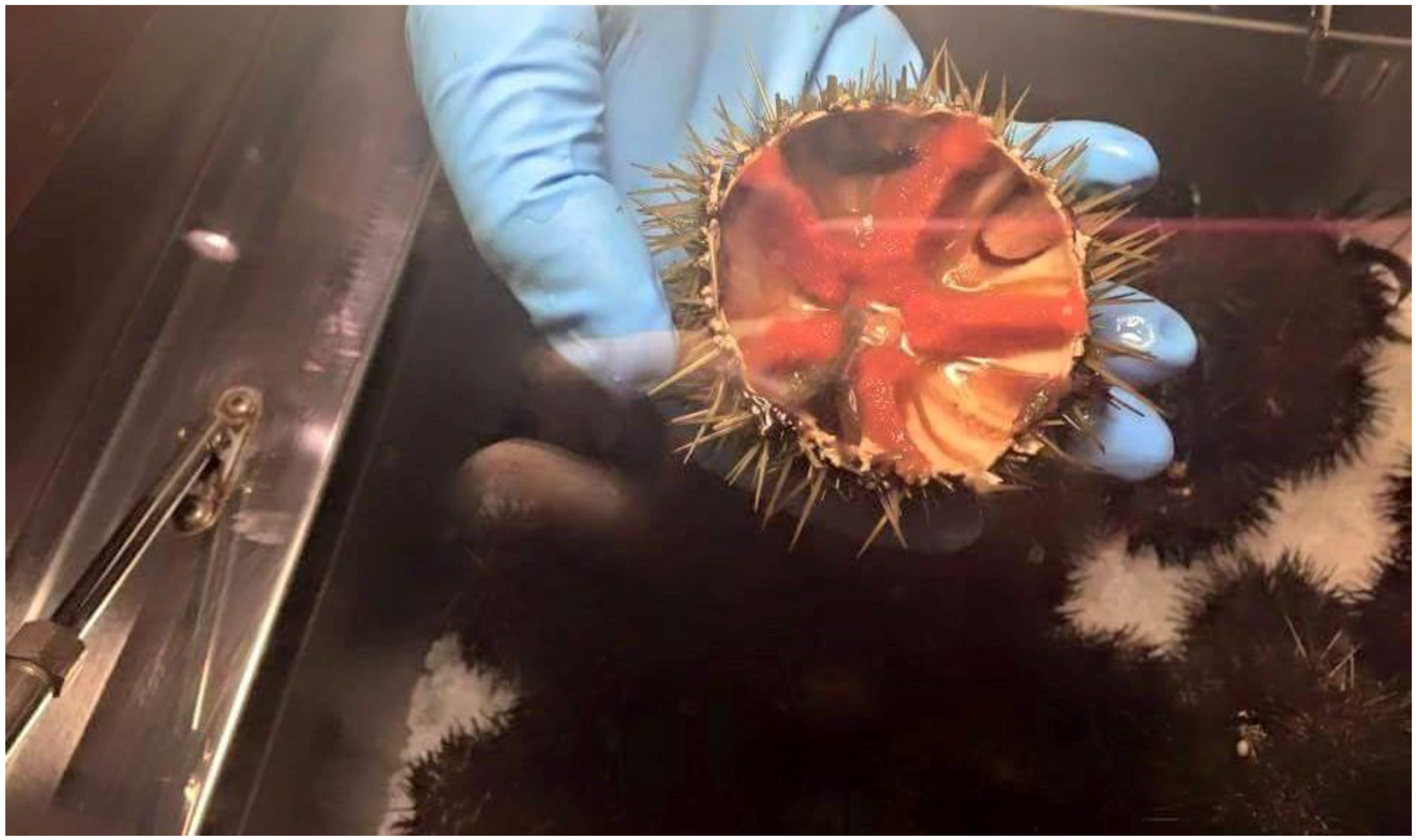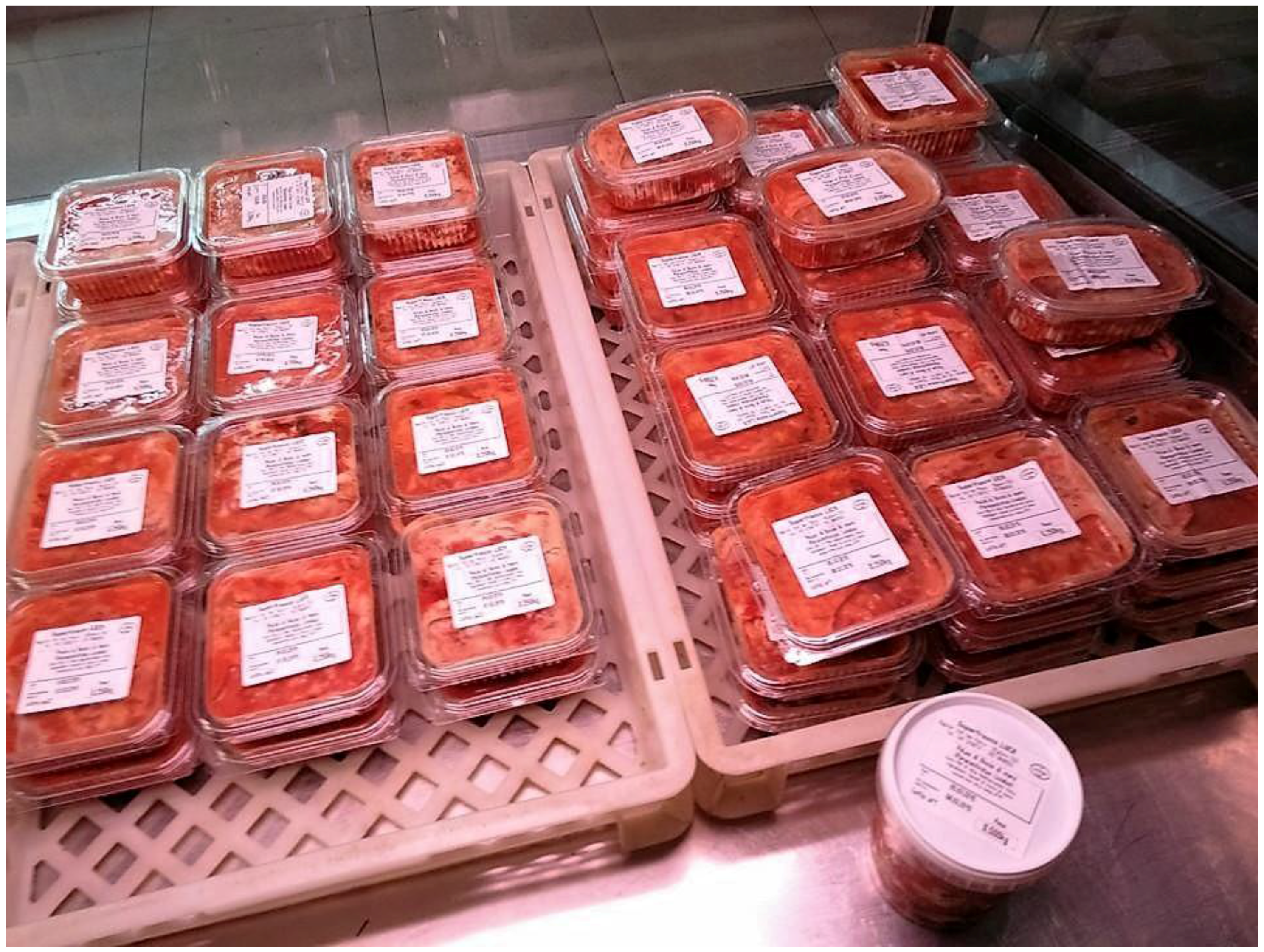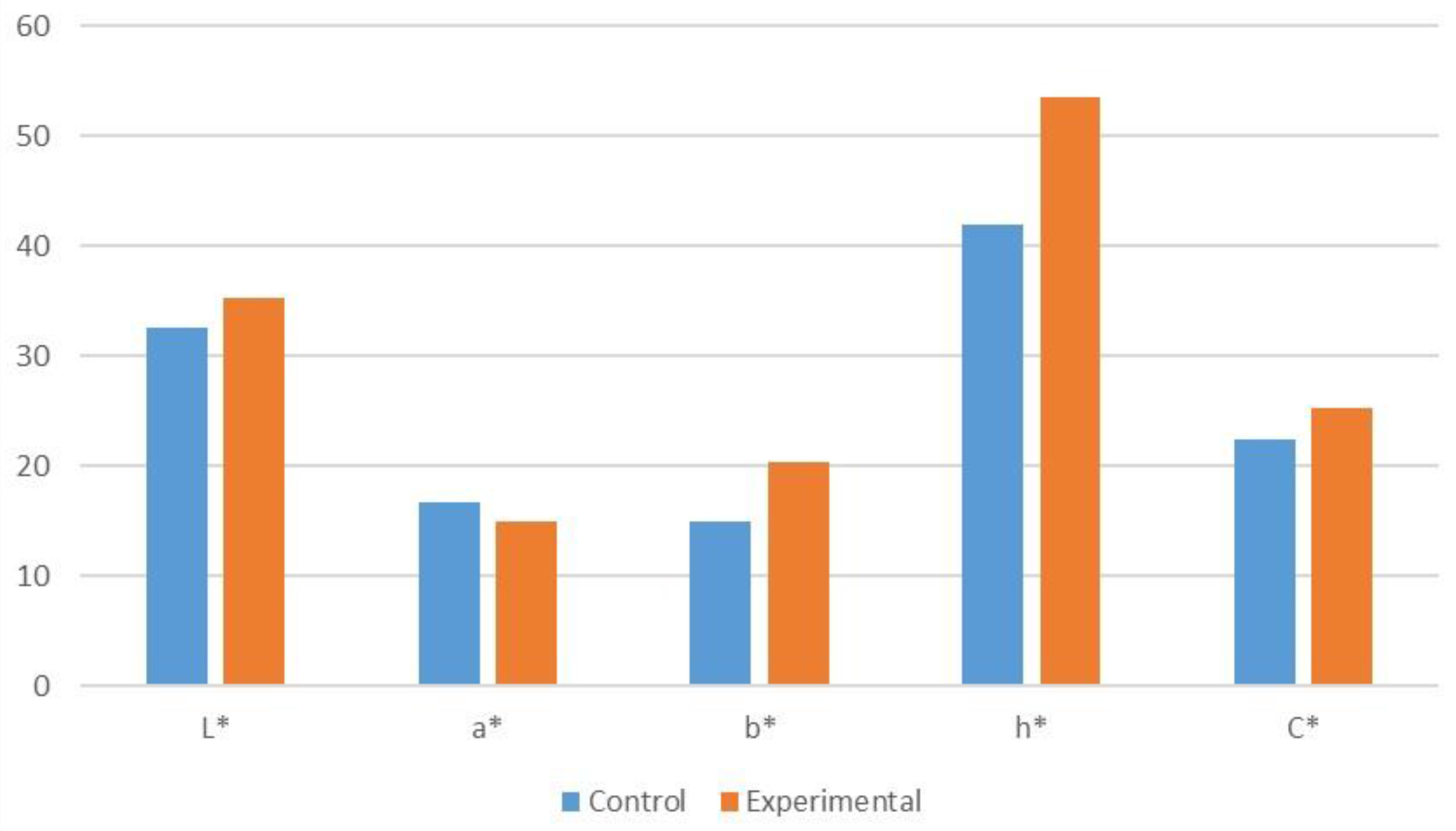A Rapid Colorimetric Method Reveals Fraudulent Substitutions in Sea Urchin Roe Marketed in Sardinia (Italy)
Abstract
:1. Introduction
2. Materials and Methods
2.1. Collection of the Samples
2.2. Sensorial Analysis
2.3. Preparation of the Samples for the Colorimetric Analysis
2.4. Colorimetric Analysis
2.5. Statistical Analysis
3. Results
4. Discussion
5. Conclusions
Author Contributions
Conflicts of Interest
References
- Boudouresque, C.F.; Verlaque, M. Ecology of Paracentrotus lividus. In Edible Sea Urchins: Biology and Ecology; Lawrence, J.M., Ed.; Elsevier: Amsterdam, The Netherlands, 2011; pp. 177–216. [Google Scholar]
- Pais, A.; Chessa, L.A.; Serra, S.; Ruiu, A.; Meloni, G.; Donno, Y. The impact of commercial and recreational harvesting for Paracentrotus lividus on shallow rocky reef sea urchin communities in North-western Sardinia, Italy. Estuar. Coast. Shelf Sci. 2007, 73, 589–597. [Google Scholar] [CrossRef]
- United Nations Food and Agriculture Organization. The State of World Fisheries and Aquaculture 2014: Opportunities and Challenges. Available online: http://www.fao.org (accessed on 16 October 2015).
- Régis, M.B.; Pérés, J.M.; Gras, G. Données pre´liminaires sur l’exploitation de la ressource Paracentrotus lividus dans le quartier maritime de Marseille. Vie Mar. 1986, 7, 41–60. (In Franch) [Google Scholar]
- Guidetti, P. Consumers of sea urchins, Paracentrotus lividus and Arbacia lixula, in shallow Mediterranean rocky reefs. Helgol. Mar. Res. 2004, 58, 110–116. [Google Scholar] [CrossRef]
- Ceccherelli, G.; Pinna, S.; Sechi, N. Evaluating the effects of protection on Paracentrotus lividus distribution in two contrasting habitats. Estuar. Coast. Shelf Sci. 2009, 81, 59–64. [Google Scholar] [CrossRef]
- Ceccherelli, G.; Pais, A.; Pinna, S.; Sechi, N.; Chessa, L.A. Human impact on Paracentrotus lividus: The result of harvest restrictions and accessibility of locations. Mari. Biol. 2011, 158, 845–852. [Google Scholar] [CrossRef]
- Matsiori, S.; Aggelopoulos, S.; Tsoutsou, A.; Neofitou, C.; Soutsas, K.; Vafidis, D. Economic value of conservation. The case of the edible sea urchin Paracentrotus lividus. J. Environ. Prot. Ecol. 2012, 13, 269–274. [Google Scholar]
- Fernandez-Boan, M.; Fernandez, L.; Freire, J. History and management strategies of the sea urchin (Paracentrotus lividus) fishery in Galicia (NW Spain). Ocean Coast. Manag. 2012, 69, 265–272. [Google Scholar] [CrossRef]
- Grisolia, J.M.; Lopez, F.; de Dios Ortùzar, J. Sea urchin: From plague to market opportunity. Food Qual. Prefer. 2012, 25, 46–56. [Google Scholar] [CrossRef]
- Barnes, D.K.A.; Crook, A.C. Implications of temporal and spatial variability in Paracentrotus lividus populations to the associated commercial coastal fishery. Hydrobiologia 2001, 465, 95–102. [Google Scholar] [CrossRef]
- Robinson, S.M.C.; Castell, J.D.; Kennedy, E.J. Developing suitable color in the gonads of cultured sea urchins (Strongylocentrotus droebachiensis). Aquaculture 2002, 206, 289–303. [Google Scholar] [CrossRef]
- Pearce, C.M.; Daggett, T.L.; Robinson, S.M.C. Effect of urchin size and diet on gonad yield and quality in the green sea urchin (Strongylocentrotus droebachiensis). Aquaculture 2004, 233, 337–367. [Google Scholar] [CrossRef]
- Whitaker, R.; Quinlan, W.; Daley, C.; Parsons, J. Developing markets for feed lot sea urchins. Bull. Aquacul. Assoc. Can. 1997, 97, 42–44. [Google Scholar]
- Olin, P.G. Preliminary trials for red sea urchin enhancement using prepared artificial diets. In Proceedings of Conference for shellfish Growers: Clam and Oyster Farming, Olympia, WA, USA, 3–4 March 1997; pp. 45–46.
- Regione Autonoma della Sardegna. Decreto n. 2423/DecA/49 del 15.10.2015. Calendario della pesca del riccio di mare (Paracentrotus lividus) per la stagione 2015/2016. 2015. Available online: http://www.regione.sardegna.it/documenti/1_22_20151019173801 (accessed on 21 October 2015).
- Pais, A.; Chessa, L.A.; Serra, S.; Meloni, G.; Ruiu, A.; Manunza, B. Morphometric relationships and annual gonad index of the edible sea urchin Paracentrotus lividus from North western Sardinia. Biol. Mar. Mediter. 2006, 13, 202–203. [Google Scholar]
- Carboni, S.; Addis, P.; Cau, A.; Atack, T. Aquaculture Could Enhance Mediterranean Sea Urchin Fishery, Expand Supply. Glob. Aquacul. Adv. 2012, 15, 44–45. [Google Scholar]
- Furesi, R.; Madau, F.A.; Pulina, P.; Pais, A. Profitability and Sustainability of Sea Urchin Fishing in Sardinia (Italy). In Proceedings of the 21th Conference of the European Association of Fisheries Economics (EAFE), Edinburgh, UK, 15–17 April 2013.
- Furesi, R.; Madau, F.A.; Palomba, A.; Pulina, P. Stated Preferences for Consumption of Sea Urchin: A Choice Experiment in Sardinia (Italy). Int. J. Food Sys. Dyna. 2014, 3, 111–119. [Google Scholar]
- Pulina, P. Economia del riccio di mare in Sardegna. 2014. Available online: http://www.sardegnaagricoltura.it/documenti/14_43_20141017125530 (accessed on 16 October 2015).
- McBride, S.C.; Price, R.J.; Tom, P.D.; Lawrence, J.M.; Lawrence, A.L. Comparison of gonad quality factors: Color, hardness and resilience, of Strongylocentrotus franciscanus between sea urchins fed prepared feed or algal diets and sea urchins harvested from the Northern California fishery. Aquaculture 2004, 233, 405–422. [Google Scholar] [CrossRef]
- Shpigel, M.; Schlosser, S.C.; Ben-Amotz, A.; Lawrence, A.L.; Lawrence, J.M. Effects of dietary carotenoid on the gut and the gonad of the sea urchin Paracentrotus lividus. Aquaculture 2006, 261, 1269–1280. [Google Scholar] [CrossRef]
- Carboni, S.; Hughes, A.; Atack, T.; Tocher, D.; Migaud, H. Influence of broodstock diet on somatic growth, fecundity, gonads carotenoids and larval of sea urchin. Aquacul. Res. 2013. [Google Scholar] [CrossRef]
- Griffiths, M.; Perrot, P. Seasonal changes in the carotenoid of sea urchin Strongylocentrotus droebachiensis. Compar. Bio. Physiol. 1976, 55, 435–441. [Google Scholar]
- Watts, S.A.; Boettger, S.A.; McClintock, J.B.; Lawrence, J.M. Gonad production in the sea urchin Lytechinus variegatus (Lamarck) fed prepared diets. J. Shellfish Res. 1998, 17, 1591–1595. [Google Scholar]
- Hutchings, J.B. Food Color and Appearance; Apsen Publishers: Gaithersburg, MD, USA, 1995. [Google Scholar]
- Agatsuma, Y. Aquaculture of the sea urchin (Strongylocentrotus nudus) transplanted from coralline flats in Hoikkaido Sea. J. Shellfish Res. 1998, 17, 1541–1547. [Google Scholar]
- Woods, C.M.C.; James, P.J.; Moss, G.A.; Wright, J.; Siikavuopio, S. A comparison of the effect of urchin size and diet on gonad yield and quality in the sea urchin Evechinus chloroticus Valenciennes. Aquacul. Int. 2007, 16, 49–68. [Google Scholar] [CrossRef]
- Carboni, S.; Hughes, A.; Atack, T.; Tocher, D.; Migaud, H. Fatty acid profiles during gametogenesis in sea urchin (Paracentrotus lividus): Effects of dietary inputs on gonad, egg and embryo profiles. Comp. Bioch. Physiol. A Mol. Int. Physiol. 2013, 164, 76–82. [Google Scholar] [CrossRef] [PubMed]
- Addis, P.; Moccia, D.; Secci, M. Effect of two different habitats on spine and gonad colour in the purple sea urchin Paracentrotus lividus. Mar. Ecol. 2014, 14, 1–7. [Google Scholar]
- BRITISH STANDARD-ISO. BS-ISO 4120: 2004. Sensory analysis-Methodology-Triangle test; ISBN 0 580 44005 2. 2004; Available online: http://58.22.191.153/jpkc/UpFile/file/spapjyjs3/BS%20ISO%204120-2004.pdf (accessed on 21 November 2014).
- Commission Internationale de l’Eclairage. Colorimetry—Part 4: CIE 1976 L*a*b* Colour Spaces; Publication CIE: Vienna, Austria, 2008. [Google Scholar]
- Granato, D.; de Araújo Calado, V.M.; Jarvis, B. Observations on the use of statistical methods in Food Science and Technology. Food Res. Int. 2014, 55, 137–149. [Google Scholar] [CrossRef]
- Douglas, R.; Duane, T.; Steinhauer, J.; Wee, A.G. Intraoral determination of the tolerance of dentists for perceptibility and acceptability of shade mismatch. J. Prost. Dent. 2007, 97, 200–208. [Google Scholar] [CrossRef] [PubMed]
- European Commission. Commission Regulation (EU) 1379/2013 of the European Parliament and of the Council of 11 December 2013 on the common organisation of the markets in fishery and aquaculture products, amending Council Regulations (EC) No 1184/2006 and (EC) No 1224/2009 and repealing Council Regulation (EC) No 104/2000. Official J. Eur. Union 2013, 354, 1–21. [Google Scholar]
- Heine, R.G.; Laske, N.; Hill, D.J. The diagnosis and management of egg allergy. Curr. Allergy Asthma Rep. 2006, 7, 145–152. [Google Scholar] [CrossRef]
- European Commission. Commission Regulation (EU) 1169/2011 of the European Parliament and of the Council on the provision of food information to consumers, amending Regulations (EC) No 1924/2006 and (EC) No 1925/2006 of the European Parliament and of the Council, and repealing Commission Directive 87/250/EEC, Council Directive 90/496/EEC, Commission Directive 1999/10/EC, Directive 2000/13/EC of the European Parliament and of the Council, Commission Directives 2002/67/EC and 2008/5/EC and Commission Regulation (EC) No 608/2004. Official J. Eur. Union 2011, 304, 18–63. [Google Scholar]



| Source | df | L* | a* | b* | C* | h* | ||||||||||
|---|---|---|---|---|---|---|---|---|---|---|---|---|---|---|---|---|
| MS | F | p | MS | F | p | MS | F | p | MS | F | p | MS | F | p | ||
| Between groups | 1 | 21.933 | 3.822 | >0.05 | 10.146 | 5.944 | <0.05 | 85.922 | 16.839 | <0.05 | 23.192 | 3.669 | >0.05 | 400.769 | 101.289 | <0.05 |
| Within groups | 10 | 5.739 | 1.707 | 5.102 | 6.322 | 3.957 | ||||||||||
| Total | 11 | |||||||||||||||
© 2016 by the authors; licensee MDPI, Basel, Switzerland. This article is an open access article distributed under the terms and conditions of the Creative Commons Attribution (CC-BY) license (http://creativecommons.org/licenses/by/4.0/).
Share and Cite
Meloni, D.; Spina, A.; Satta, G.; Chessa, V. A Rapid Colorimetric Method Reveals Fraudulent Substitutions in Sea Urchin Roe Marketed in Sardinia (Italy). Foods 2016, 5, 47. https://doi.org/10.3390/foods5030047
Meloni D, Spina A, Satta G, Chessa V. A Rapid Colorimetric Method Reveals Fraudulent Substitutions in Sea Urchin Roe Marketed in Sardinia (Italy). Foods. 2016; 5(3):47. https://doi.org/10.3390/foods5030047
Chicago/Turabian StyleMeloni, Domenico, Antonio Spina, Gianluca Satta, and Vittorio Chessa. 2016. "A Rapid Colorimetric Method Reveals Fraudulent Substitutions in Sea Urchin Roe Marketed in Sardinia (Italy)" Foods 5, no. 3: 47. https://doi.org/10.3390/foods5030047






